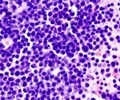- Scientists have found that a rabbit virus, myxoma, can act on human multiple myeloma cells and eliminate them.
- 25% of mice were rid of multiple myeloma on treatment with myxoma.
- 65% of mice showed reduction in cancer after treatment with myxoma.
Multiple Myeloma
Multiple myeloma is a type of blood cancer, which is found to develop in the plasma cells present in the bone marrow. The plasma cells are responsible for the development of antibodies that are vital for the maintenance of a healthy immune system.Viral Oncolytics
In the quest to identify a new approach that would provide an effective treatment for multiple myeloma, Dr. Eric C. Bartee, who is an assistant professor of Microbiology and Immunology at MUSC, along with his colleagues used viral oncolytics to solely target and destroy the target cancer cells. The highlight of the study has been that the use of these oncolytics resulted in the destruction of the cancer cells but with no sign of relapse.The current study has been the result of several years of study by Dr. Bartee who has been using the myxoma virus to destroy multiple myeloma cells in culture. This virus, in nature, affects only rabbits and is not infectious to humans. However, when this virus was added to the multiple myeloma cancer cell lines, it was found to kill human multiple myeloma cell lines.
Stem Cell Transplant
Stem cells of the patient are often used to treat multiple myeloma patients but they have a high chance of relapsing into cancer due to the presence of cancer cells in the stem cells. Studies have shown that treating these stem cells with the myxoma virus aided in eliminating multiple myeloma cells, a technique that was carried out prior to administration to the patients. This would, therefore, prevent relapse.Systemic Treatment with Myxoma Virus
The scientists wondered if the successful removal of the multiple myeloma cells from the stem cells would ensure destruction of the cancer cells beyond the concept of transplantation. When the MYXV was introduced as a systemic treatment, it resulted in- 66% of mice showed decrease in disease progression.
- 25% of mice showed complete elimination of disease with no sign of relapse.
Host Immune System
The MYXV is a rabbit virus and is not found to replicate in the human multiple myeloma (MM) cells, the elimination of cancer could be due to the immune system of the host. The bone marrow was unaffected by the introduction of the virus.- The immune system of the host remained functional
- It could fight against the cancer
- Administration of MYXV increased CD8+ cells
- The large scale production of this virus
- Demonstrating a high response rate in human studies
Resistance to Therapy
Patients who undergo many cycles of chemotherapy may develop resistance but it is very difficult for multiple myeloma patients to develop resistance to the virus.The non-traditional method of therapy needs to undergo extensive testing and trials before it enters mainstream therapy, but the hope of an effective treatment method is significant.
References:
- What is Multiple Myeloma? - (https://www.themmrf.org/multiple-myeloma/what-is-multiple-myeloma/)
- Eric Bartee, Mee Y Bartee, Bjarne Bogen, Xue-Zhong Yu. Systemic therapy with oncolytic myxoma virus cures established residual multiple myeloma in mice. Molecular Therapy — Oncolytics, 2016; 3: 16032 DOI: 10.1038/mto.2016.32











